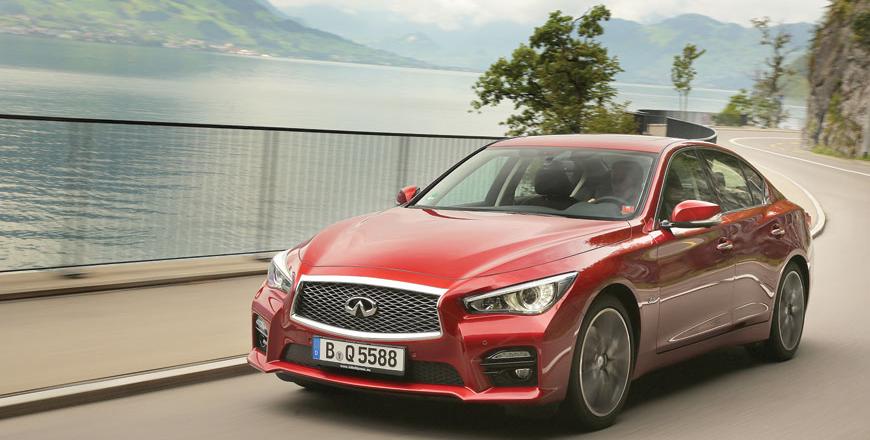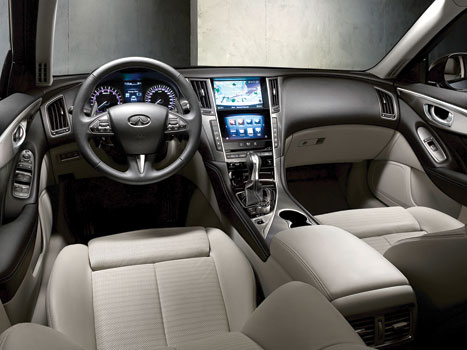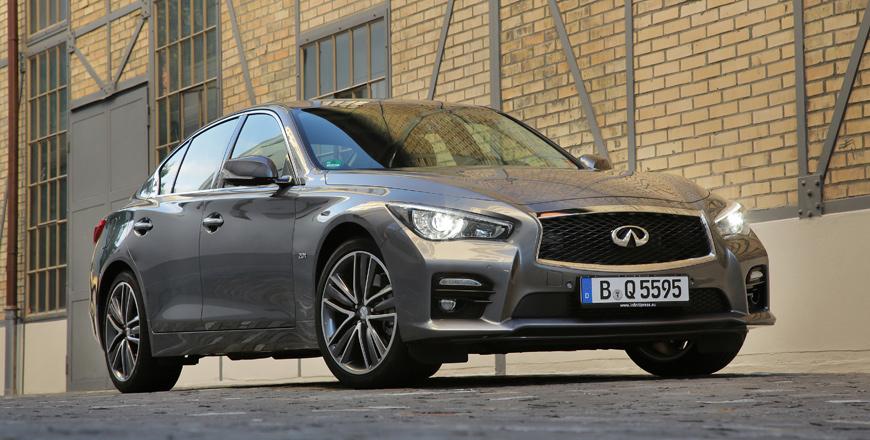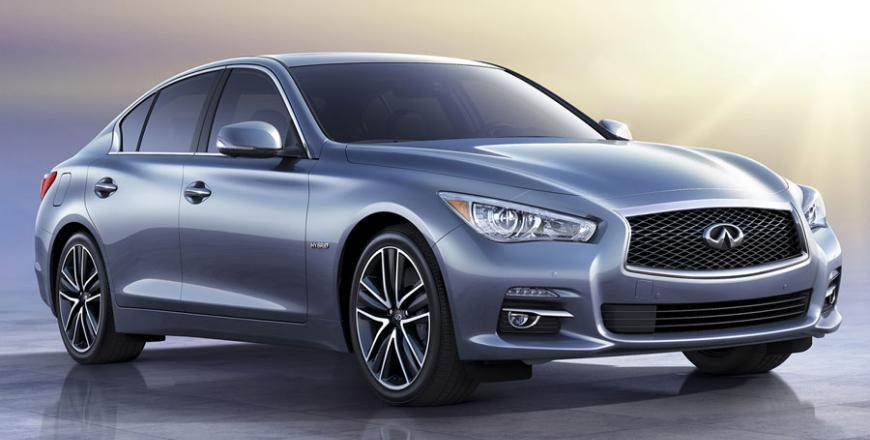You are here
Dramatic and dynamic dark horse
By Ghaith Madadha - Nov 09,2015 - Last updated at Nov 09,2015

Photo courtesy of Infiniti
The first car bearing Infiniti’s new “Q”-based nomenclature, the Q50 first launched in 2013 as the world’s first car with advanced steer-by-wire technology. Succeeded the superbly sporty, smooth and capable but sometimes unsung G-Sedan, the Q50’s sharply styling and urgent and striking design lines well-suited the premium brand’s association with the then Formula One championship-winning Infiniti Red Bull.
An innovative, strikingly assertive and refined compact executive saloon pitched against cars like the Audi A4, BMW 3-Series, Mercedes-Benz C-Class and Jaguar XE, the Q50 2.0T is among the sportier in its class. Complementing the Q50’s more powerful V6 models, the turbocharged 2-litre 2.0T version driven offers improved fuel efficiency and confident mid-range ability.
Sculpted and sophisticated
Founded in 1989 with US market in its sights and recently relocated to Hong Kong for a more global repositioning, Nissan-owned Infiniti shares conceptual similarities with Toyota’s Lexus brand, but with dramatic design, luxurious execution and sporty instinct, is closer to BMW. Discrete and not beholden to outdated preconceptions as some rivals, Infiniti enjoys a dark horse sense of appeal.
A complex but uncomplicated and fluidly assertive design, the Infiniti Q50 is slightly larger in dimension to its predecessor, and features distinctly muscular and sculpted surfacing, with low 0.26 aerodynamic drag co-efficient and zero lift. Moodily aggressive, the Q50 features squinting browed headlights and wide honeycomb grille, which are separated by ridged lines trailing to the A-pillars.
Emphasising its’ rearwards cabin and classic front-engine, rear-drive layout, the Q50 features short front overhang and a generous distance between A-pillars and wheel-arches. Sophisticated and urgent with a demeanour brimming with dynamic tension, the Q50’s chiselled front bumper, rear window kinks, dual tailpipes and built-in rear spoiler create a sporty sense of forward motion even when motionless.
Confident and efficient

Offered with either 3.7-litre or 3.5-litre hybrid V6 engines when first launched, the Q50 2.0T however arrived last year with a 2-litre turbocharged four-cylinder engine. Intended for China and developing markets like Jordan, the 2.0T is confident, efficient and downsized and is part of a more diversified and globally-minded Q50 model range that was offered by its’ G-sedan predecessor.
Sourced from Mercedes-Benz as part of technological partnership and used by its Mercedes C250 rival, the Infiniti Q50 2.0T’s direct injection 2
-litre engine produces 208BHP at 5500rpm and a versatile 258lb/ft throughout a 1250-3500rpm mid-range. Driving its rear wheels via a smooth and quick shifting 7-speed automatic gearbox, the 2.0T delivers modest 6.3l/100km combined cycle fuel consumption.
Responsively muscular, the 2.0T suffers scant turbo lag from tickover and pulls hard from low-end. A wide, early-arriving and healthy torque band provides consistently solid mid-range ability and versatility for confident hill climbs and overtaking. Dispatching the 0-100km/h dash in 7.2-seconds, the 2.0T’s delivery is consistent and generous as accumulates maximum power, and is capable of a 230km/h top speed.
Finesse and fluency
Riding on fixed-rate double wishbone front and multi-link rear suspension, the Q50 is refined, smooth and settled at speed. Through winding roads, the 2.0T version driven offers agile, pointy and responsive handling. With lighter front-end, drift-friendly instinct and near ideal weight balance, the Q50 delivers neutral, predictable, adjustable and progressive at-the-limit handling.
Best finessed through hill climbs and switchbacks with tidy inputs and an intuitively technical driving, rather thrashed against electronic stability thresholds, the Q50 proved rewardingly exploitable and accessible. Quick, refined and fluent mechanical steering rather than optional steer-by-wire provides crisp and eager turn-in. If entering too fast or tight, slight understeer is easily corrected by pivoting weight transfer to the outside rear and tightening the cornering line.
Controlled and taut through sprawling switchbacks, the Q50 is confident and precise, turning in smoothly, swiftly and gripping well at the rear when leaned on. Precisely driven, the Q50 is fluent, tidy and swift out of corners, as one comes smoothly back on throttle by apex, to maintain traction, and simultaneously begins smoothly unlocking the steering.
Sophisticated and spacious

Reassuring and convenient the Q50’s 225/55R17 run-flat tyres free up boot space for a 500-litre total volume. And with its’ stiff run-flat sidewalls and sporty suspension, the Q50 rides slightly firm, but is settled, smooth and refined from harshness, noise and vibrations, and remains buttoned down over imperfections and on rebound.
Sophisticated and well-appointed, the Q50’s cabin features quality leathers, soft textures and rear passenger room better than most competitors. Luxurious but not overstated, the Q50’s well-adjustable seats and steering provide an alert driving position, and instrumentation and controls are intuitively driver-oriented, and include two large infotainment touch screens, from which driving mode menus are accessed.
Well-equipped, the driven Q50 2.0T featured Active Lane Control driver assistance, reversing camera, parking sensors and Active Trace Control, which uses selective braking for enhanced cornering agility. Fitted with dual zone climate control, USB and Bluetooth connectivity, cruise control, sunroof and Isofix childseat latches, the 2.0T also features other standard and optional equipment.
TECHNICAL SPECIFICATIONS
Engine: 2-litre, in-line, turbocharged 4 cylinders
Bore x stroke: 83 x 92mm
Compression: 9.8:1
Valve-train: 16 valve, DOHC, direct injection
Gearbox: 7 speed automatic, rear-wheel-drive
Power, BHP (PS) [kW]: 208 (211) 155 @5500rpm
Specific power: 104.5BHP/litre
Power-to-weight: 121.28BHP/tonne
Torque, lb/ft (Nm): 258 (350) @1250-3500rpm
Specific torque: 175.79Nm/litre
Torque-to-weight: 204.08Nm/litre
0-100km/h: 7.2 seconds
Top speed: 245km/h
Fuel consumption, urban/extra-urban/combined: 8.6/5/6.3 litres/100km
CO2 emissions, combined: 146g/km
Fuel capacity: 80 litres
Height: 1445mm
Width: 1820mm
Length: 4790mm
Wheelbase: 2850mm
Track, F/R: 1540/1570mm
Aerodynamic drag co-efficient: 0.26
Kerb weight: 1715kg
Luggage volume: 500 litres
Steering: Electric-assisted rack and pinion
Turning diameter: 11.4-metres
Suspension, F/R: Double wishbones/multi-link, twin tube dampers, stabiliser bars
Brakes, F/R: Ventilated discs, 330mm/308mm
Tyres: 225/55R17
Price, as tested: JD47,900 on-the-road, no insurance
Related Articles
First launched in 2013 with the featured entry-level 2.0t model arriving the following year, the Infiniti Q50 is the Honk Kong-based Japanes
Innovatively high-tech yet viscerally connected, the Infiniti Q50 first appeared as 2014 model year sports saloon successor to the acc
A high-tech replacement for the Infiniti G Sedan, the new Q50 compact premium saloon is the luxury brand’s first new offering since recently relocating to Hong Kong and reasserting itself as a global and urbane sports luxury brand.


















